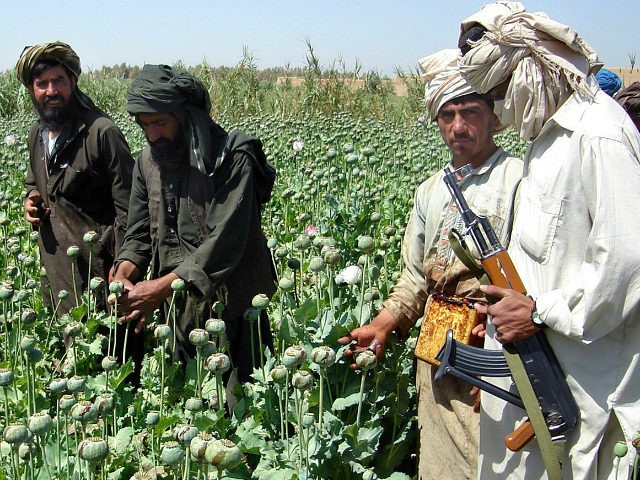The unprecedented 9,000 tons of opium produced in Afghanistan last year will trigger a “wave of high quality, low-cost heroin” that will reach consumers across the world and inject tens of millions into the Taliban’s coffers, the United Nations warned on Monday.
Despite more than $8 billion in American taxpayer funds devoted to counternarcotics operations in Afghanistan since the war started about 17 years ago, the South Asian country produced nearly 50 times more opium last year than in 2001 (185 tons) when the United States invaded the country, Breitbart News has determined.
Although the U.S. government acknowledges that the vast majority of heroin in neighboring Canada originates from Afghanistan, the Drug Enforcement Agency (DEA) has for years insisted that only a small amount of the Afghan drug comes into the United States.
Given the purity levels of between 50 and 70 percent of the Afghan heroin expected to flood streets across the world, even a minute amount can be deadly.
The United Nations has identified Europe and Asia as the major consumer markets for Afghan heroin, adding in a report released Monday:
Each year thousands of tons of opium are produced in Afghanistan and then converted into heroin to reach end-consumer markets around the globe. With the record high of production in 2017, a wave of high quality, low cost heroin is expected to reach consumer markets across the world. … Unprecedented amounts of heroin will reach consumer markets across the world, with increased consumption and related harms as a likely consequence.
Opium and its heroin derivative are the top sources of funding for Taliban terrorists, who are killing and maiming American troops as well as thousands of Afghan securing forces and civilians each year.
Some U.S. officials estimate that the deadly drugs generate more than 60 percent of the Taliban’s funding. More production means additional funds for Taliban narco-jihadists to continue waging their terror campaign.
U.N. investigators note:
The significant levels of opium poppy cultivation and illicit trafficking of opiates will further fuel instability, insurgency and increase funding to terrorist groups in Afghanistan, which in turn impedes licit, economic development.
…
The Taliban secured at least US$ 26 million in taxes from the farm-gate value of opium alone and up to U.S.$ 116 million if they collected a similar share of taxes on the earnings from onwards manufacturing and trafficking of opiates in Afghanistan.
Overall, the levels of opium cultivation and production in Afghanistan for 2017 were “worth between U.S.$ 4.1 to 6.6 billion in 2017,” according to the U.N.
That amounts to between “20 and 32 percent of [Afghanistan’s] GDP,” the report adds, further noting, “The value of opiate economy exceeded by far the value of Afghanistan’s licit exports of goods and services in 2016 (7 percent of GDP).”
An unprecedented opioid crisis is currently gripping the United States, devastating families across America.
In 2016, the latest year for which data is available, the number of deaths in the United States (42,249) linked to opioids, including synthetic fentanyl, exceeded the number of fatalities (25,621) at the hands of terrorists across the world, according to U.S. and U.N. data.
Opioids are killing more than 100 people each day in the United States alone.
According to the DEA, the majority of heroin in the United States comes from Latin America, and most of the fatal synthetic opioid fentanyl originates in China.
U.S. President Donald Trump’s administration has deemed heroin and fentanyl to be national security threats. The president has vowed to deal with the overall number of fatal drug overdoses, which reached a record number of more than 60,000 in 2016.
Cultivation and production of opium and its heroin derivative has reached historic levels in Afghanistan over the last few years along with opioid fatalities in the United States.
Some U.S. officials have urged the American government to probe a possible link between the two growing problems.
Authorities have investigated some American troops for possessing, using, or distributing heroin and other opiates.
U.S. military troops have also fallen victim to fatal opiate overdoses while serving in Afghanistan.
Since the opioid problem reached historic proportions, the Pentagon has refused to release new figures on the opium problem among American forces in Afghanistan. Judicial Watch is suing the government for access to the data.

COMMENTS
Please let us know if you're having issues with commenting.